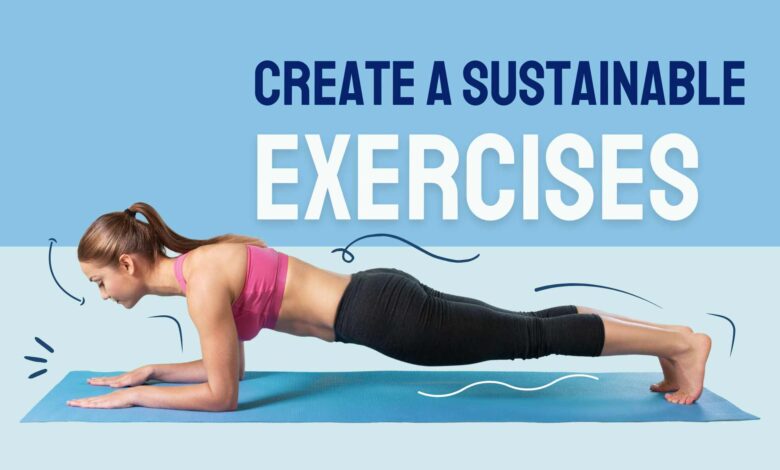

In today’s fast-paced world, maintaining a healthy lifestyle can feel like a constant battle. Between work deadlines, family commitments, and social commitments, finding time to exercise can be difficult.
However, the benefits of regular physical activity are undeniable. Exercise improves your physical health, increases your mental well-being, and increases your energy levels. Unfortunately, many people get discouraged by unrealistic fitness goals and unsustainable exercise routine. The key to success is building sustainable exercise habits that you can realistically maintain over time.
This essay explores the basic principles for creating sustainable exercise habits. We help you understand your motivations, find activities that suit your preferences, set realistic goals, overcome common obstacles, and develop Exercise Routine that fit seamlessly into your lifestyle. I will work on it.
By following these principles, you can create a sustainable exercise program that benefits your body, mind, and overall health.
Table of Contents
Understand your why: find your motivation
The first important step to creating a sustainable exercise routine is understanding your “why.” Why do you want to be more active? What motivates you to develop an exercise routine? Do you want to improve your cardiovascular health, lose weight, build muscle, or simply feel more energized throughout the day? Be clear about your “why.” Understanding can be a powerful support when challenges or motivation drop.
Common reasons why people start exercising are:
Improve your physical health: Exercise helps manage your weight, strengthen your heart and lungs, reduce your risk of chronic diseases like diabetes and heart disease, and strengthen your bones and muscles.
Improves mental health: Physical activity is an effective way to combat stress, improve mood, improve sleep quality, and boost self-confidence. Improved energy levels: Regular exercise fights fatigue, improves stamina, and keeps you feeling energized throughout the day.
Improve your appearance: Exercise helps you maintain a healthy weight, increase muscle tone, and improve your overall fitness, all of which contribute to a positive self-image.
Stress Relief: Exercising releases endorphins, which are natural mood enhancers that fight stress and anxiety.
Once you know your “why,” write it down and keep it somewhere you’ll see it regularly to remind yourself of your goal.
Find the activity that’s right for you: Activities you’ll enjoy
Exercise shouldn’t feel like a punishment. If you choose activities that you truly enjoy, you’re more likely to stick with the exercise routine. It’s important to explore different options. You will be surprised when you discover hidden gems.
Here are some popular activities to consider.
- Aerobic exercise: running, swimming, cycling, dancing, HIIT workouts, jumping rope
- Strength training: bodyweight training, weight lifting, resistance bands
- Mind and Body: Yoga, Pilates, Tai Chi
- Team sports: basketball, soccer, volleyball
- Outdoor activities: hiking, cycling, kayaking, tennis
Don’t be afraid to experiment! If you are not satisfied with an activity, try another activity. You may also consider combining different activities for a more complete workout experience.
Set smart goals: achievable milestones
Setting goals is important for progress, but unrealistic goals can cause frustration and hinder progress. Instead, focus on setting SMART goals that are specific, measurable, achievable, relevant and time-bound.
- Specific: Define your goals based on activities and results, rather than vague goals like “get in shape.” For example: “run a 5K in six months” or “do 30 push-ups in a row in three months.”
- Measurable: Track your progress to stay motivated. This might include logging your workouts, timing yourself, measuring changes in your body composition, etc.
- Achievable: Be realistic about your current fitness level. Start with small, achievable goals and gradually increase the difficulty over time.
- Relevance: Make sure your goals align with your overall “why.” Do they help you work towards your main motivator? Time-bound: Set deadlines for achieving your goals. This gives you a goal to focus on and helps maintain a sense of urgency.
The key is to break down your big goals into smaller, manageable steps. Celebrate your successes, no matter how small, to build confidence and strengthen your commitment to your exercise routine.
Also Read: Top 5 Home Workouts for Busy Professionals
Conclusion
Creating a sustainable exercising ordinary is a adventure that requires consistency, flexibility, and self-awareness. By putting practical dreams, prioritizing activities you enjoy, and progressively growing your efforts, you may make fitness a permanent part of your life-style. It’s important to bear in mind that each character’s health journey is precise—what works for someone else may not be just right for you.
Incorporating variety into your ordinary can help save you boredom and reduce the hazard of overuse injuries. Listening for your frame and taking rest days when wanted is equally critical, because it guarantees long-time period development and stops burnout. Staying stimulated can be difficult, however monitoring your achievements and celebrating small milestones can hold you inspired.
A sustainable workout ordinary isn’t pretty much physical health—it additionally complements intellectual properly-being, improves sleep, and boosts average self assurance. By making health an fun and non-negotiable part of your daily agenda, you’ll not simplest obtain your fitness goals but additionally construct conduct that ultimate a lifetime.
Start small, stay affected person, and embrace the method. Your dedication these days will pave the manner for a more healthy and greater enjoyable tomorrow.




